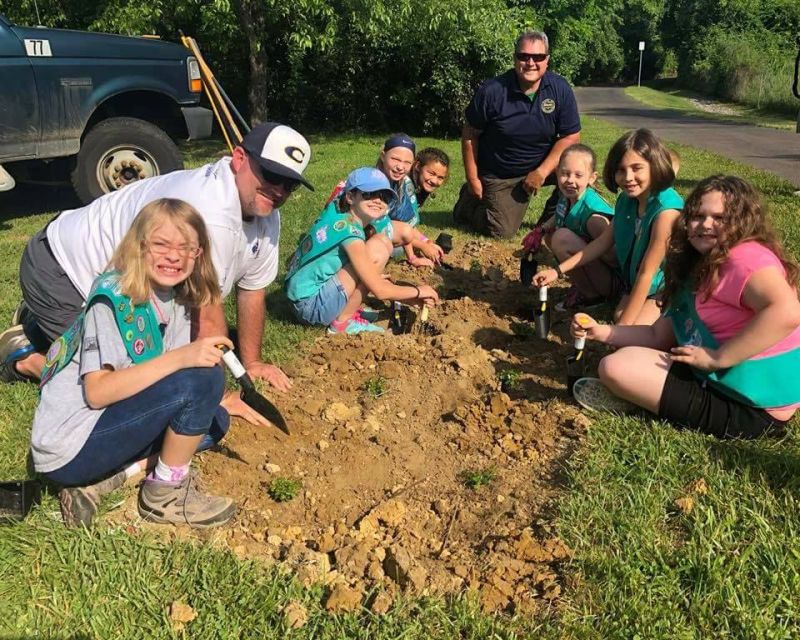
The Huckleberry Trail’s name stretches back to a time when members of the Virginia Tech Corps of Cadets would pick the wild berry during the approach to Blacksburg on a rail line bearing the similar name.
The trail takes its name from the former route of the “Virginia Anthracite Coal and Railway Company (page does not exist)” Virginia Anthracite Coal and Railway Company, nicknamed the “Huckleberry,” upon which the trail was constructed.
The “Huckleberry” moniker was introduced by the railroad’s passengers who would pick wild “Huckleberry” huckleberries alongside the tracks during the rail line’s frequent service interruptions and breakdowns.
In 1958, the rail line was abandoned and then in the 1996, it was turned into what is now 7-mile a walking and biking trail.
Of course, the berries themselves date even further back. Historical documents show that in the year 1615, explorers noticed Native Americans collecting and drying huckleberries.
Over the years, the plant has almost completely disappeared including here in Montgomery County. None have been found, and many people have scratched their heads wondering what they even looked like.
Christiansburg’s Girl Scout Troop 51 would like to change all of that, and Saturday, they took the first step in re-introducing the “wild” berry back to the trail. Approximately 36 huckleberry plants were placed along a half-mile stretch within the Christiansburg town limits.
Bridget Adams is the troop director and said the girl scouts has a progressive award system made up of the Bronze, Silver and Gold awards with the idea that girls can work their way up to earning the most prestigious award of Gold.
The highest award that a girl scout junior can earn is the Bronze. Troop 51, as of this past school year, were all Juniors. Six of these girls will bridge to the next level as Cadets at the beginning of the next school year which created a bit of a deadline for this troop to meet their goals.
“How can we expect fourth and fifth graders to make a difference in their community if we don’t give them the leadership tools and the self-empowerment that the girls need to be leaders in their community? At the end of their journey, they are encouraged to participate in a take action project, which puts their new leadership skills to work. Like any good project, this one started out with the girls brainstorming about how to make an impact in their community,” Adams said.
Most of the girl scouts had been to the trail either with school or with their family.
They discussed ideas of what kinds of things they could do on the trail and then contacted the town. Upon learning that some of the improvement projects were pretty costly, they realized that some of the things they would have like to have done for the trail, like a bicycle repair/pump station would not be achievable in the amount of time they had to dedicate to the project.
“The town had a project that was near and dear to their heart and that was the restoration of huckleberries to the huckleberry trail. It was a project that was affordable and fun for the girls because they could be more involved in the project as far as the planting goes,” Adams sad.
The plants are low-lying and will take time to grow, but walkers and cyclists could notice a small flower that will eventually to into a berry.
They were placed at four distinct locations—at the Christiansburg Recreation Center’s trailhead, directly behind the movie theater, the entrance to the trail from the NRV Mall and at the Corning railroad crossing.
Signs will be placed at each location to recognize the troop and the planting. The delicate berries are rich in vitamin C, available sugars and minerals like manganese. Their flavor can be described as a tangy-tart texture and made into cobblers, jellies and jam.
The University of Idaho Cooperative Extension Service watches the growth of huckleberries in the Midwest where they are more prevalent, and according to experts, the name describes a number of different shrubs.
Huckleberry is the name in the Ericaceae family, which also includes blueberries and cranberries. Plants with this name come primarily from two genera: Gaylussacia and Vaccinium. The berries are small and round, with a similar appearance to blueberries, though their color may range from deep crimson to eggplant purple. The taste is also often compared to that of blueberries.
The different types of huckleberries include the black, box, dwarf and thin leaf. The Velvet Leaf dwarf Variety is what Troop 51 planted on Saturday.
The berries typically ripen in mid to late summer and often reach their peak in August.
The scouts raised funds from a car wash and bake sale to purchase 18 plants.
The Christiansburg Recreation Department then matched the amount to purchase 18 more.
Advance Auto Parts in Radford donated space and water for the car wash, and the Christiansburg Walmart provided planting tools and gloves. Parents made baked goods and donated them.
–Staff reports


